Past Exhibitions

Becky Behar, L'Dor V'Dor, (From Generation to Generation), Archival pigment print.
September 4 - September 18, 2025
The Hadassah-Brandeis Institute and the Women's Studies Research Center are pleased to present photographer Becky Behar's Tu Ke Bivas in the Kniznick Gallery, an immersive presentation in which Behar traces Sephardic traditions enacted by her mother and daughter.
"Tu Ke Bivas is part of a Sephardic blessing my parents often invoked: ‘May you live, grow, and thrive like a little fish in freshwater.’ I am a Sephardic Jew, part of the diasporic population expelled from Spain during the Inquisition in the late 15th century. My family’s migrations have taken us from Turkey to Colombia to the United States. Throughout, we have maintained our Ladino language, Jewish religion, and Sephardic customs.
My photographs explore how my mother and daughter continue to enact these traditions and rituals today. As I contemplate their different ways of preserving and celebrating our history, I consider my own relationship to this heritage and what interpretations my daughter will carry forward." - Becky Behar
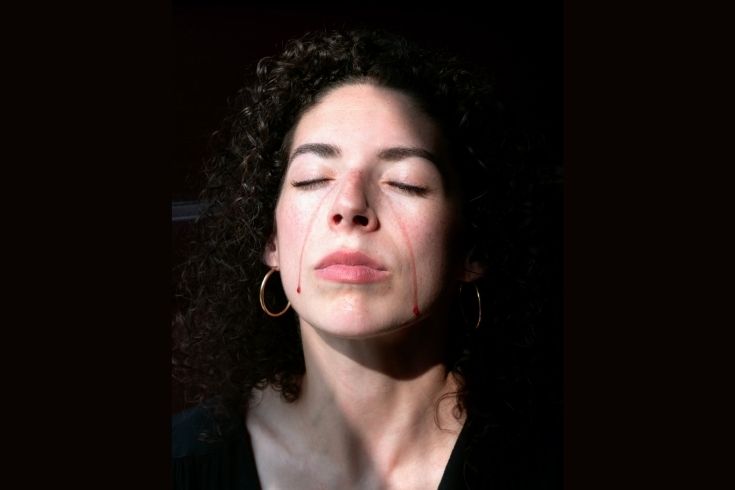
Hannah Altman, Plagues, 2024, Archival pigment print, 24 x 30 inches. Courtesy of the artist.
February 13 - June 12, 2025
In As It Were, Suspended in Midair, Hannah Altman’s photographs examine how Jewish myths are shared, inherited, and reshaped across the diaspora. Altman draws from Yiddish literature and Jewish mystical texts as she situates her female protagonists in lush landscapes and fraught interiors. Animated by sunlight, their postures, gestures, environments, and ritual objects foreshadow abundance and danger. Their mere presence threatens dominant narratives grounded in patriarchal tradition.
Still lifes interject like incantations, offering suspense and new possibilities: a corner knee-deep in salt, a hand mirror submerged in a jar, an open-palmed Baba Yaga puppet – a witch from Slavic folklore who feasted on children. Altman juxtaposes a person’s back with five thick nails puncturing their white garment and a stretched klaf – parchment paper produced from a tanned and kosherized animal inscribed with biblical passages to fit inside a mezuzah. Layering symbols and allusions, Altman builds a world that recasts and transforms Jewish ritual and folklore toward the world ahead.
Read more:
“As It Were, Suspended in Midair” Explores the Visuals of a Lineage, Joetta Maue, Issue 14: June 3, 2025, Boston Art Review
THE TICKET Things to do around Boston this weekend and beyond, February 12, 2025, Boston Globe
"As It Were, Suspended In Midair emerges as a dynamic, speculative reworking of tradition, resonating across generations and landscapes". —Kaitlyn Ovett Clark, January 2025, Boston Art Review
What Will You Remember? By Suzanne Révy
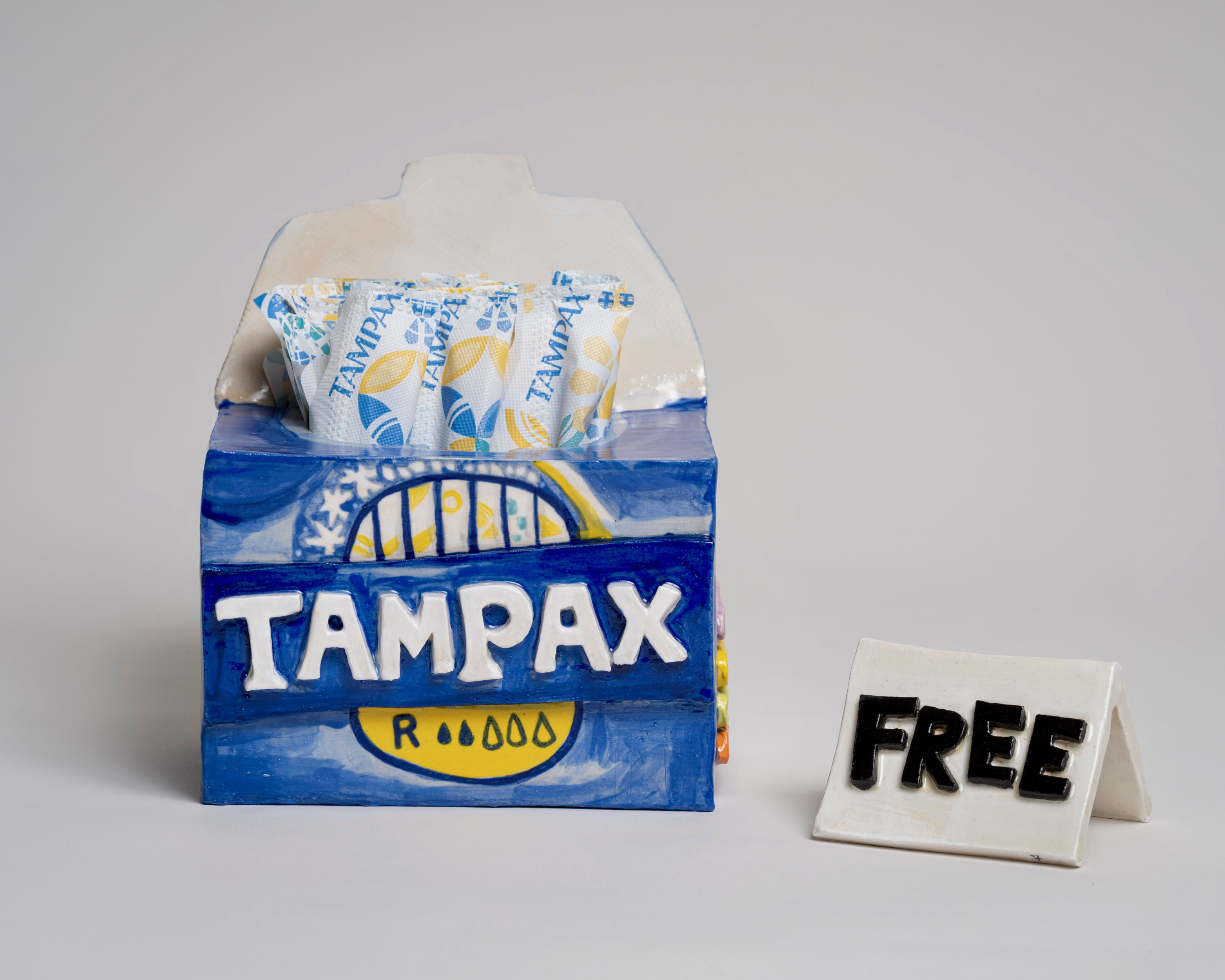
Susan Chen, Free Tampax, 2023, Ceramics installation, Tampax Box: 6 x 7 x 7.5 inches Free Sign: 3 x 3 x 2.25 inches, Courtesy the artist and Night Gallery, Photo credit: Kris Graves
Curated by Caron Tabb
November 2, 2023 - February 1, 2024
Twenty-one artists, five decades, four continents, and numerous traditions respond to abortion and reproductive justice through the lens of faith.
Deeply Rooted Artists: Lizzy Alejandro, Roya Amigh, Andi Arnovitz, Zoë Buckman, Nani Chacon and Rose B. Simpson, Susan Chen, Dell M. Hamilton, Nayana LaFond, Marla McLeod, Azita Morodkhani, Jacqueline Nicholls, Giovanna Pizzoferrato, Cora Ramirez-V, Winnie van der Rijn, Janice Rubin, Bahareh and Farzaneh Safarani, Charlie Dov Schön, Caron Tabb, Diana Weymar
View the Deeply Rooted exhibition online catalog.
Supported by grants from Combined Jewish Philanthropies/CJP and the Mass Cultural Council.
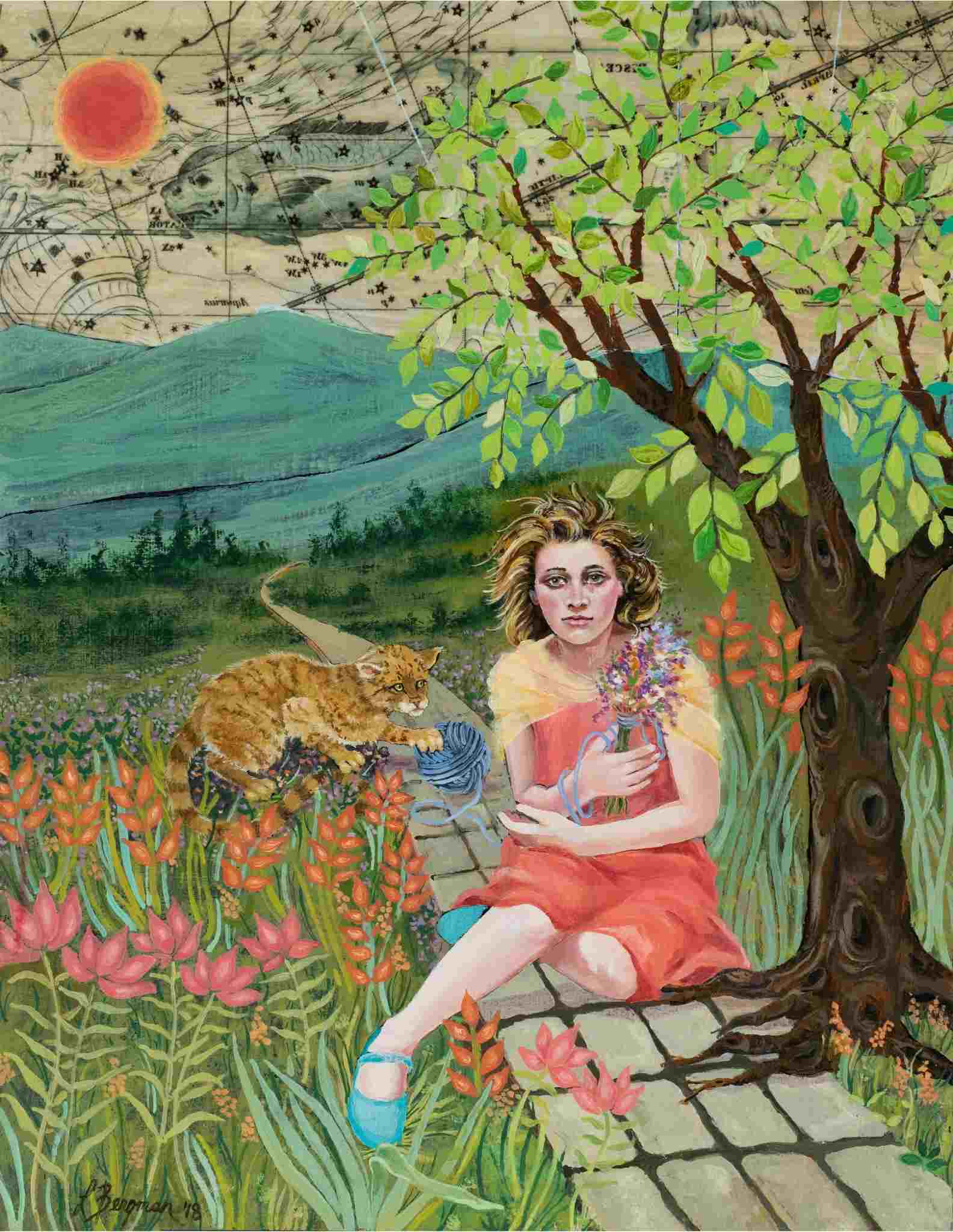
Lauren Bergman, She Dreams of Flowers, Oil on cradled panel, 18 x 14 in.
September 7 - October 25, 2023
An immersive exhibition of painting and music. Painter Lauren Bergman and composer Ella Milch-Sheriff honor young women and girls murdered in the Holocaust by using art to imagine the lives they might have led. Lives Eliminated, Dreams Illuminated is presented in partnership with the Dr. David M. Milch Foundation.
Listen to Milch-Sheriff's composition accompanying Bergman's painting, She Dreams of Flowers.
Read At Brandeis, A New Holocaust Memorial Unlike Any Other, by Kara Baskin of JewishBoston.com, and watch the powerful interviews: Art exhibit at Brandeis University reimagines lives cut short by Holocaust, by NBC Boston's Eli Rosenberg and The Times of Israel's Brandeis exhibit on women in the Holocaust holds chilling parallels to Israel today, by Rich Tenorio.
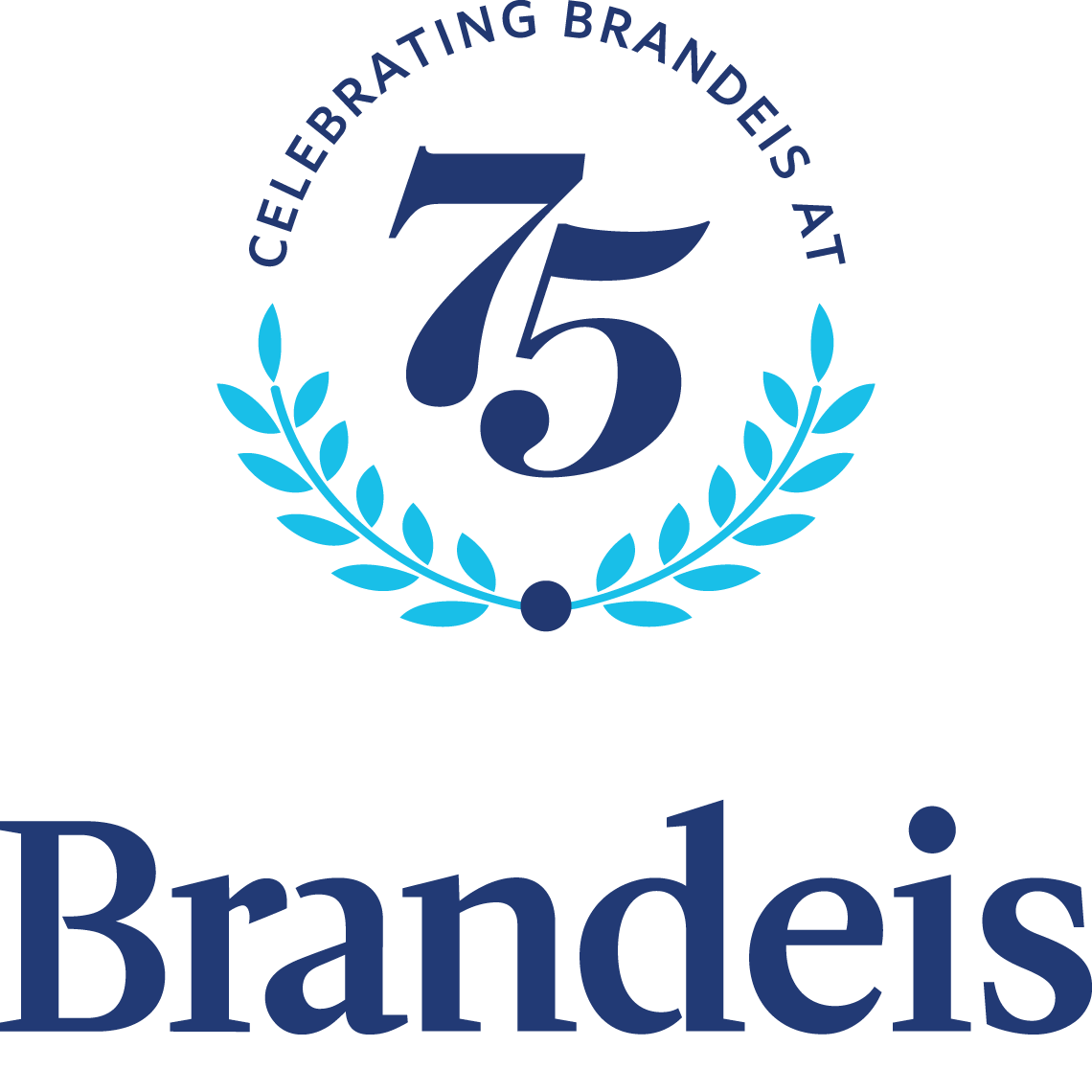
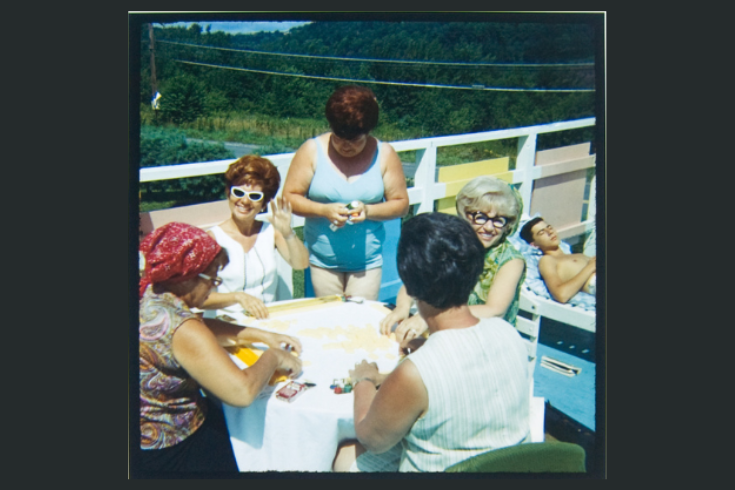
March 6 – April 14, 2023
Marisa J. Futernick’s lush, poster-size prints combine historical photographs with invented text to look at the Jewish Catskill resorts of the 1960s. Drawing from personal history while recalling a broader Jewish experience, the works evoke the atmosphere of the “Borscht Belt,” famously mythologized in mainstream culture as the setting for the film "Dirty Dancing."
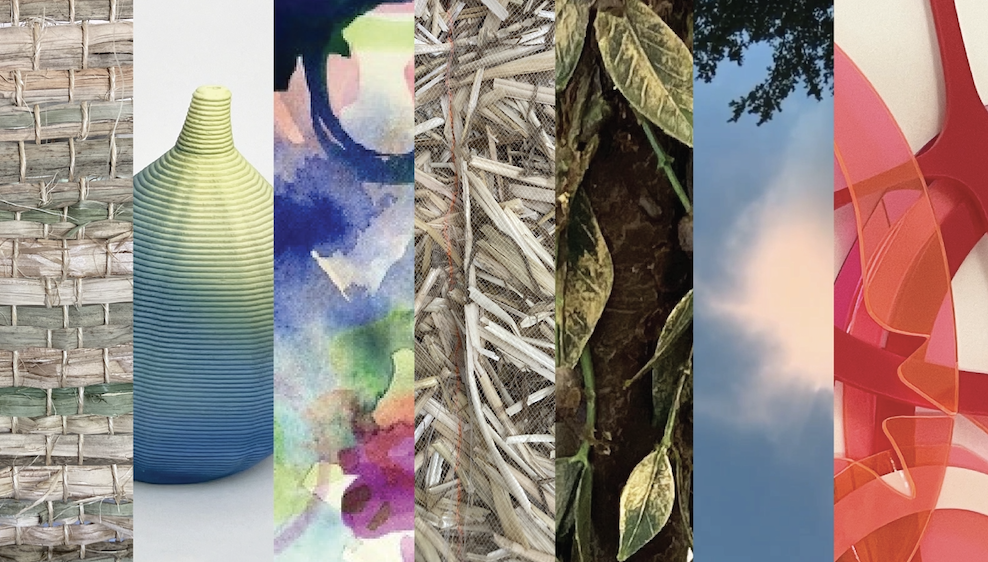
July 28-September 15, 2022
An interdisciplinary, intergenerational family of artists:
Seven artists in the Schön family offer a feminist interpretation of the seven species: wheat, barley, grapes, figs, pomegranates, olives, and dates.
Read more in The Boston Globe and JewishBoston.
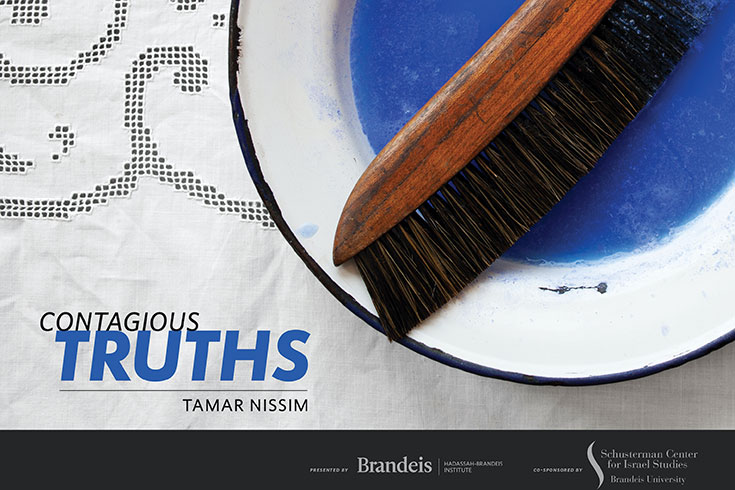
March 10 - July 8, 2022
Tamar Nissim’s videos, photographs, and objects explore how Western hygiene methods were interwoven with nationalist ideology to control women in mid-twentieth-century Israel. Nissim’s videos draw from personal interviews, archival research, and testimonies to trace the effects of these policies on women’s bodies and lives: Mizrahi immigrants who complied to prove themselves civilized; nurses who enforced strict hygiene protocols; mothers whose babies were taken away in what has come to be known as the Yemenite, Mizrahi, and Balkan Children Affair.
Glass bottles, bars of olive oil soap, and photographs of cleaning products extend the context of the videos, offering windows into these women’s environments. Pairing audio of herself and her mother with footage of her daughter, Nissim forms an intergenerational portrait. Unflinchingly, she confronts the legacy of trauma, how it remains in the body, and its possible ends.
Co-sponsor: The Schusterman Center for Israel Studies
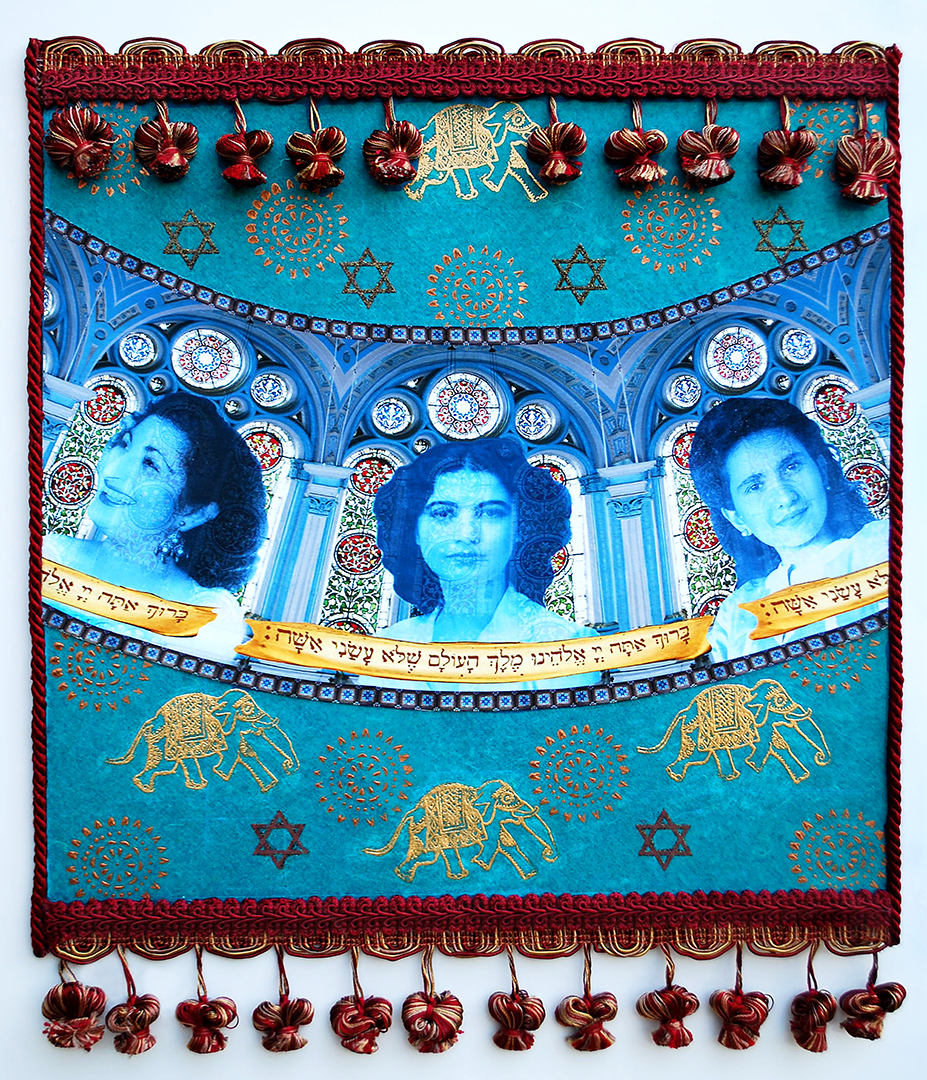
March 22 - July 2, 2021
"The Fez as Storyteller" explores deeply ingrained gender biases in cultural and religious practices through the lens of domestic relationships.
Eskell's multimedia sculptures mine two generations of her family's history as Iraqi Jews living in Bombay, India. Combining visual symbols and fabrics from Middle Eastern, South Asian and Sephardic traditions, the works exist as hybridized garments and forms of headwear. The fez cap becomes a significant armature to build upon as Eskell reflects on her maternal and paternal grandfathers' manufacturing and distribution of the hats in India. Importing French lace was another family enterprise led first by her uncle and then her father in New York; these materials in Eskell's work map a family's journey through the manufacturing of garments and materials, each existing as a form of cultural assimilation, resilience-- and a reminder of the pervasive power structures regarding gender.
Against this backdrop, Eskell's sculptures are painstakingly embellished and constructed, with images of the artist and her family grafted onto the forms. The incorporated photographs are smeared, distorted, and serve to interrupt and retell a daughter's narrative. Supported by pedestals and never worn, the works suspend the continuation of gendered values and blind family tradition.
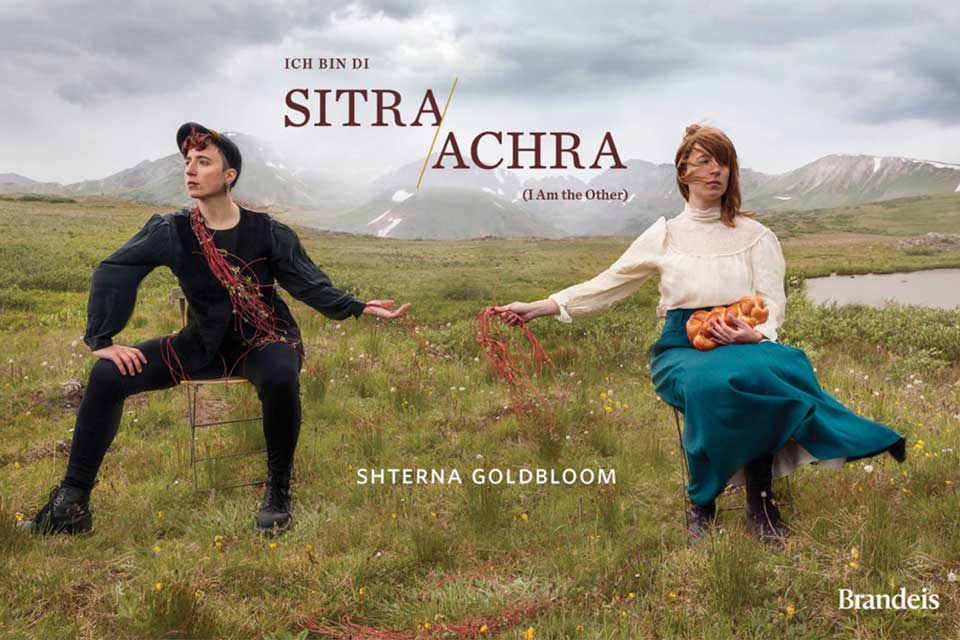
March 4 - July 3, 2020
Goldbloom’s wistful photographic self-portraits bridge memories and experiences of the artist’s own Hasidic upbringing, with historical and invented personae. As the artist transforms herself in each composed image through dress, posture and setting, her photographs come together to present a singular but complicated expression of self as a queer Jewish woman.
Goldbloom reinterprets the Hasidic term “Sitra Achra,” used to describe things considered to be on the "other side" of holiness — like queers and women who don't fit traditional definitions of femininity. In “Ich Bin Di Sitra Achra (I Am the Other),” the artist presents the many faces that can exist between tradition and heresy. Her gesture before the camera makes these conflicting identities visible, giving agency to those who might otherwise be obscured.
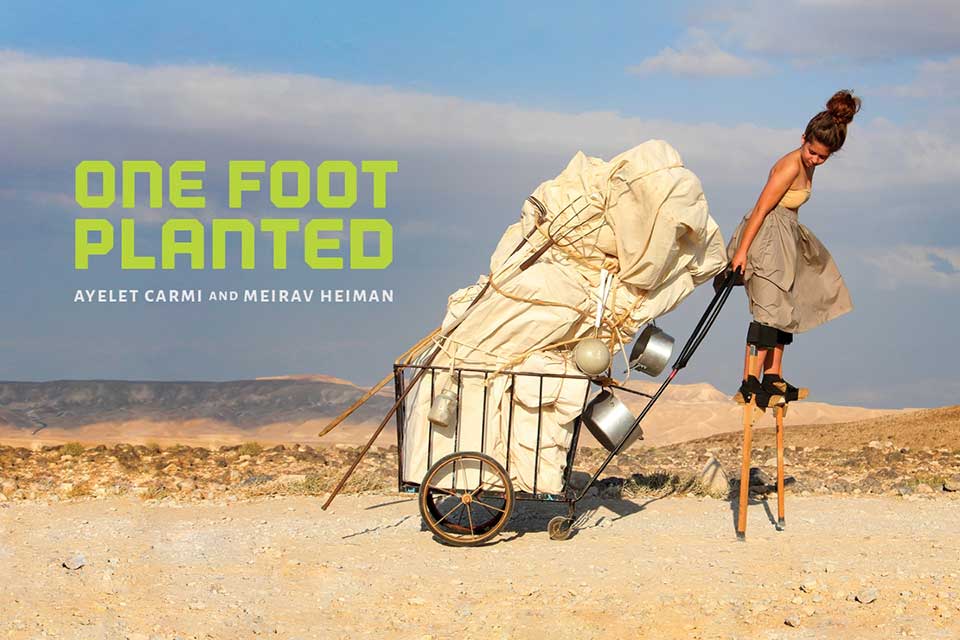
Feb. 28 - June 28, 2019
Israeli artists Carmi and Heiman create ambitious video works that explore the impact that politics and conflict have on Israeli women in times of crisis. In their work, Israel is redefined as a mythical and post-apocalyptic world, which feminine bodies must ritually traverse through extreme physical acts. Both the ritual of processing the Israel Trail and counting the Omer become ungendered and labor-intensive sites of communication between bodies, land, machines and the movement of time itself. In creating these spectacles and invented worlds, the artists’ combined interests in cinematography, live-action performance, group dynamics and mechanical inventions are all at play.
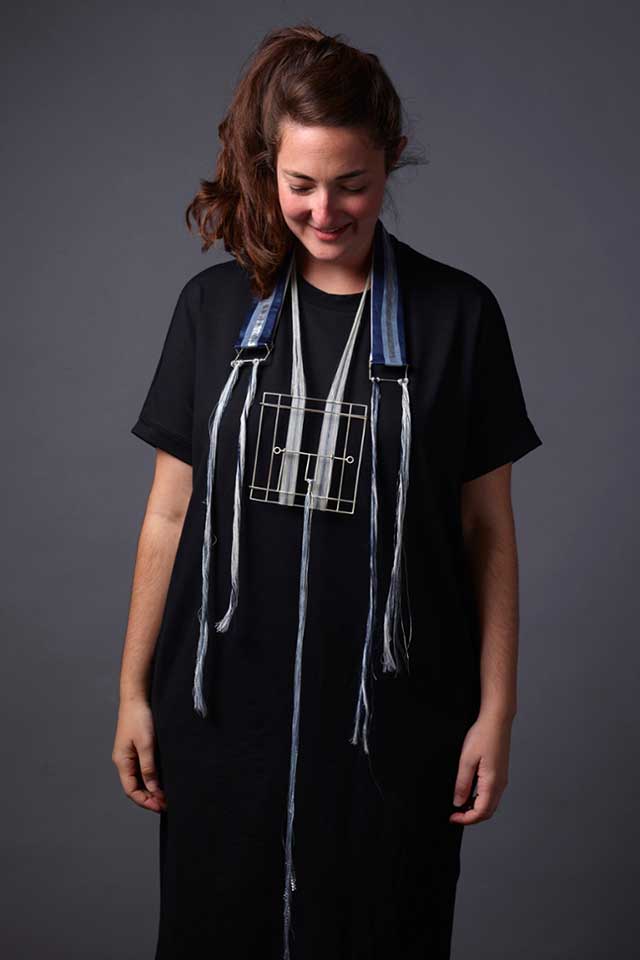
March 5 - June, 22, 2018
The Hadassah-Brandeis Institute is proud to present Israeli artist Tamar Paley.“A Fringe of Her Own,” features Paley's collection of handmade Jewish ritual objects that deconstruct and reinterpret the tallit, tzitzit, and tefillin, typically worn by men. Traditionally, the tzitzit, or fringes, hold special significance as a reminder of one’s spiritual obligations. In Paley’s collection of wearable objects, the fringes become a delicate sculptural form.
Recognizing the gap that exists between Jewish women and these ritual objects — and with a growing need to provide a feminine interpretation of patriarchal religious practice — Paley’s work offers a reshaping of traditional patriarchal forms from a female perspective using materials, text and symbolism that acknowledge the physical and spiritual experiences of women in Judaism.
HBI Artist-in-Residence Program
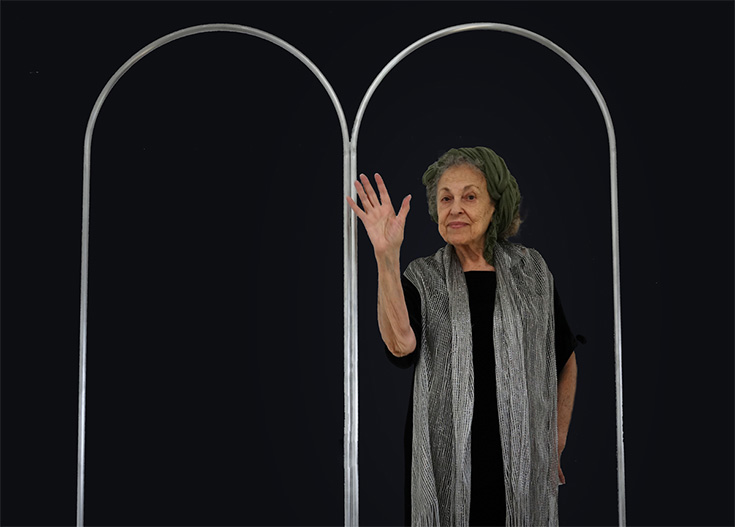
Internationally-acclaimed Jewish feminist artist Helène Aylon presented her conclusion to “The G-d Project: Nine Houses Without Women,” her 20-year series highlighting the dismissal of women in Jewish traditions and text. In “Afterword: For the Children,” Aylon dedicated her finale in the series to the future generations, challenging all who regard The Ten Commandments not to shrug off a dark foreboding which emanates in her view, from the patriarchy — not from God.
The text of the Second Commandment holds future generations responsible for the sins of their fathers. The artist’s examination of this text reveals a universal dilemma through its connection to contemporary policies and practices that shape the world our children will inherit. The concept of tikkun olam (correction of the world) holds significance in Aylon’s immersive digital installation, as her continuous attempt at “repairing” the revered text becomes a quiet yet assertive protest.
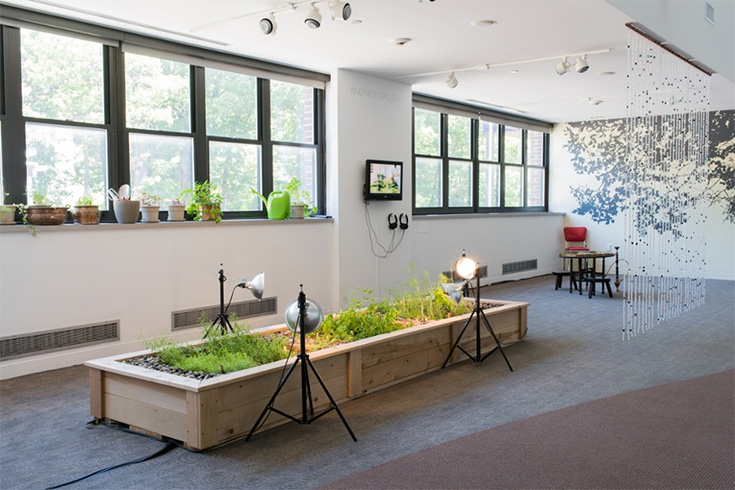
The 2016 Artist-in-Residence at the Hadassah-Brandeis Institute was Wendy Wolfe Fine. Fine's “The Pearl that Slipped Its Shell” relayed the experiences of Jewish women in Iran as a result of the Islamic Revolution of 1979, specifically those of the Mizrahi family who immigrated to the United States and carry on Iranian Jewish traditions. Fine’s immersive installation incorporated video, photography and cultural objects to re-envision transformation and loss in the personal freedoms and cultural lives of Iranian Jewish women after the Revolution, when their country shifted from a secular state to a theocracy of Islamic fundamentalism.
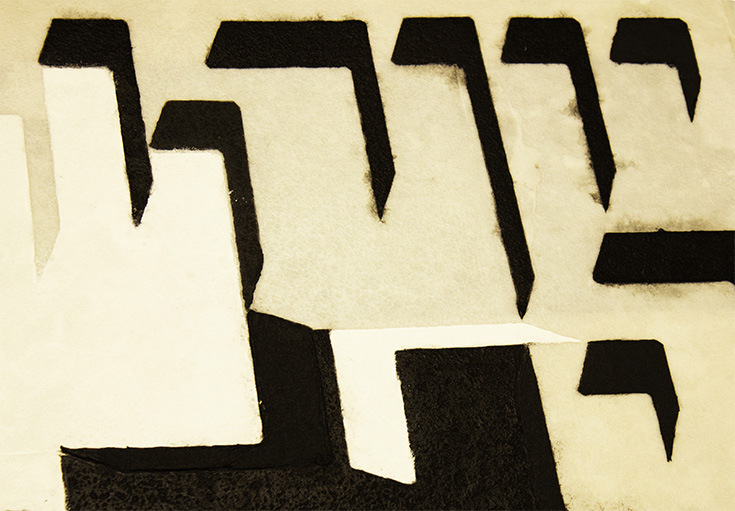
The 2015 Artist-in-Residence at the Hadassah-Brandeis Institute was Milcah Bassel, Brandeis Post-Baccalaureate in Studio Art '11. Working onsite at the Kniznick Gallery, Bassel focused on large-scale drawings based on five letters of the Hebrew alphabet. Multiplying and playing with the space between these letters provided the basis for a multidisciplinary installation that explored space both as movement and time through an altered language.
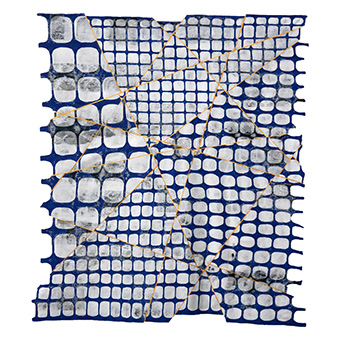
The 2014 Artist-in-Residence at the Hadassah-Brandeis Institute was Jeanne Williamson. Working onsite at the Kniznick Gallery, Williamson created a series of Jewish wedding canopies, or chuppot, that were displayed on campus and in the gallery during the exhibition. Using simple printmaking techniques, Williamson brought pattern and color to the traditional chuppah.
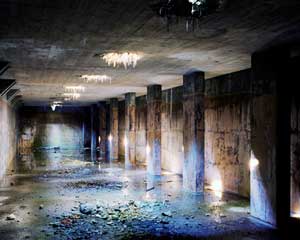
HBI was thrilled to announce the selection of Berlin-based Israeli artist Yishay Garbasz as the fifth annual Hadassah-Brandeis Institute Artist-in-Residence. Her month-long residency at the Women's Studies Research Center culminated in a multimedia exhibition of photographs, video and text celebrating Jewish women who identify as transgender. Through interviews and portraits, Garbasz gave voice to a segment of the Jewish population that has been little discussed until recently, showing her subjects with their loved ones and families, at their jobs or in their homes. The artist said, “By showing that these individuals are part of relationships that are familiar to us, it is the first step toward [creating] a larger, more diverse Jewish community.”
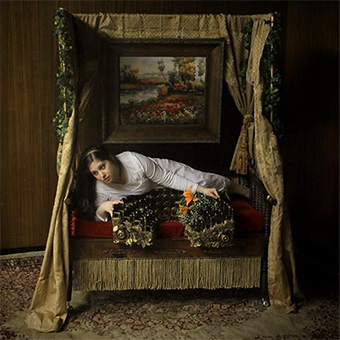
Sarah Zell Young's exhibition for the WSRC/HBI, “Occupy Sanhedrin,” examined roles — both religious and secular — for Jewish women from the Second Temple to the present and explored how bodies can become hazarded in the pursuit of justice. In addition to photographs, the exhibition featured a large, site-specific installation — an interactive and participatory rendition of a Sanhedrin (rabbinic supreme court). By granting access to an historical space of justice — making it physical — Young invited viewers to engage with traditional ideas and received wisdom of judicatory in a new way and to achieve personal agency over their own relationship to history. Sarah Young received her BFA in Sculpture from the Rhode Island School of Design and is studying toward her MFA in combined media from Hunter College, New York.
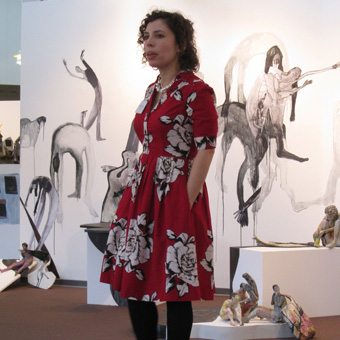
Jessica Riva Cooper’s original, site-specific drawing and ceramics installation reinterpreted the folkloric stories of the Golem, a creature created to do a person’s bidding without question, and the Dybbuk, a mischievous spirit, through a feminist lens.
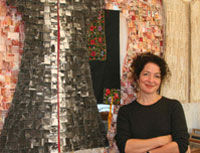
Acclaimed Israeli artist Andi Arnovitz created an exhibition of her recent work titled “Tear/Repair (kriah/ichooi).” As the second annual Hadassah-Brandeis Institute artist-in-residence, Arnovitz created sketches for a new body of work — a series of paper coats for Jewish women who have impacted history and changed the world. These coats are an extension of Arnovitz's “Garments of Faith” series, which were also on view. Each of these garments, fabricated from torn or intact papers, scrolls and book pages, represented injustices for Jewish women. The works addressed challenges throughout history — from halachic and spiritual issues, to those of co-existence and, above all, issues related to gender.
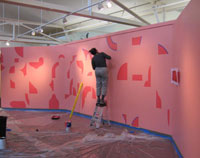
Words and images meld, the conceptual becomes tangible and history met modernity in Lynne Avadenka’s site-specific installation. In spring 2008 at the Kniznick Gallery, HBI hosted its first artist-in-residence in an exhibition celebrating eloquence, bravery and wit. Avadenka’s “A Thousand and One Inventions” boldly transformed the gallery’s unique architecture into a work of art. Painting, drawing and assemblage created an environment that opens up and reveals layers visually, as a book does conceptually. Unprecedented in the artist’s oeuvre in scope and scale, “A Thousand and One Inventions” expanded on the themes in Avadenka’s limited edition artist’s book, “By A Thread.” Created in 2004 with a grant from HBI, the book imagines a conversation between Queen Esther, the heroine of Purim, and Scheherazade, the teller of a thousand and one tales. Both women spoke up when they could have remained silent and saved many lives through their fortitude.
